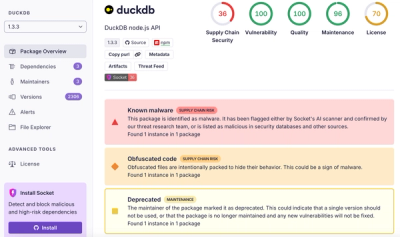
Product
Introducing Tier 1 Reachability: Precision CVE Triage for Enterprise Teams
Socket’s new Tier 1 Reachability filters out up to 80% of irrelevant CVEs, so security teams can focus on the vulnerabilities that matter.
@foliojs-fork/restructure
Advanced tools

Restructure allows you to declaratively encode and decode binary data. It supports a wide variety of types to enable you to express a multitude of binary formats without writing any parsing code.
Some of the supported features are C-like structures, versioned structures, pointers, arrays of any type, strings of a large number of encodings, enums, bitfields, and more. See the documentation below for more details.
Because on original repo is not possible release new version on npm see foliojs/restructure#45. This fork is same as original repo and is maintained up-to-date.
npm install @foliojs-fork/restructure
This is just a small example of what Restructure can do. Check out the API documentation below for more information.
var r = require('restructure');
var Person = new r.Struct({
name: new r.String(r.uint8, 'utf8'),
age: r.uint8
});
// decode a person from a buffer
var stream = new r.DecodeStream(buffer);
Person.decode(stream); // returns an object with the fields defined above
// encode a person from an object
// pipe the stream to a destination, such as a file
var stream = new r.EncodeStream();
stream.pipe(fs.createWriteStream('out.bin'));
Person.encode(stream, {
name: 'Devon',
age: 21
});
stream.end();
All of the following types support three standard methods:
decode(stream) - decodes an instance of the type from the given DecodeStreamsize(value) - returns the amount of space the value would take if encodedencode(stream, value) - encodes the given value into the given EncodeStreamRestructure supports a wide variety of types, but if you need to write your own for some custom use that cannot be represented by them, you can do so by just implementing the above methods. Then you can use your type just as you would any other type, in structures and whatnot.
The following built-in number types are available:
uint8, uint16, uint24, uint32, int8, int16, int24, int32, float, double, fixed16, fixed32
Numbers are big-endian (network order) by default, but little-endian is supported, too:
uint16le, uint24le, uint32le, int16le, int24le, int32le, floatle, doublele, fixed16le, fixed32le
To avoid ambiguity, big-endian may be used explicitly:
uint16be, uint24be, uint32be, int16be, int24be, int32be, floatbe, doublebe, fixed16be, fixed32be
Booleans are encoded as 0 or 1 using one of the above number types.
var bool = new r.Boolean(r.uint32);
The Reserved type simply skips data in a structure, where there are reserved fields.
Encoding produces zeros.
// 10 reserved uint8s (default is 1)
var reserved = new r.Reserved(r.uint8, 10);
The Optional type only encodes or decodes when given condition is truthy.
// includes field
var optional = new r.Optional(r.uint8, true);
// excludes field
var optional = new r.Optional(r.uint8, false);
// determine whether field is to be included at runtime with a function
var optional = new r.Optional(r.uint8, function() {
return this.flags & 0x50;
});
The Enum type maps a number to the value at that index in an array.
var color = new r.Enum(r.uint8, ['red', 'orange', 'yellow', 'green', 'blue', 'purple']);
The Bitfield type maps a number to an object with boolean keys mapping to each bit in that number,
as defined in an array.
var bitfield = new r.Bitfield(r.uint8, ['Jack', 'Kack', 'Lack', 'Mack', 'Nack', 'Oack', 'Pack', 'Quack']);
bitfield.decode(stream);
var result = {
Jack: true,
Kack: false,
Lack: false,
Mack: true,
Nack: true,
Oack: false,
Pack: true,
Quack: true
};
bitfield.encode(stream, result);
Extracts a slice of the buffer to a Node Buffer. The length can be a constant, or taken from
a previous field in the parent structure.
// fixed length
var buf = new r.Buffer(2);
// length from parent structure
var struct = new r.Struct({
bufLen: r.uint8,
buf: new r.Buffer('bufLen')
});
A String maps a JavaScript string to and from binary encodings. The length can be a constant, taken
from a previous field in the parent structure, or encoded using a number type immediately before the string.
Supported encodings include 'ascii', 'utf8', 'ucs2', 'utf16le', 'utf16be', and if you also install
iconv-lite, many other legacy codecs.
// fixed length, ascii encoding by default
var str = new r.String(2);
// length encoded as number before the string, utf8 encoding
var str = new r.String(r.uint8, 'utf8');
// length from parent structure
var struct = new r.Struct({
len: r.uint8,
str: new r.String('len', 'utf16be')
});
// null-terminated string (also known as C string)
var str = new r.String(null, 'utf8')
An Array maps to and from a JavaScript array containing instances of a sub-type. The length can be a constant,
taken from a previous field in the parent structure, encoded using a number type immediately
before the string, or computed by a function.
// fixed length, containing numbers
var arr = new r.Array(r.uint16, 2);
// length encoded as number before the array containing strings
var arr = new r.Array(new r.String(10), r.uint8);
// length computed by a function
var arr = new r.Array(r.uint8, function() { return 5 });
// length from parent structure
var struct = new r.Struct({
len: r.uint8,
arr: new r.Array(r.uint8, 'len')
});
// treat as amount of bytes instead (may be used in all the above scenarios)
var arr = new r.Array(r.uint16, 6, 'bytes');
The LazyArray type extends from the Array type, and is useful for large arrays that you do not need to access sequentially.
It avoids decoding the entire array upfront, and instead only decodes and caches individual items as needed. It only works when
the elements inside the array have a fixed size.
Instead of returning a JavaScript array, the LazyArray type returns a custom object that can be used to access the elements.
var arr = new r.LazyArray(r.uint16, 2048);
var res = arr.decode(stream);
// get a single element
var el = res.get(2);
// convert to a normal array (decode all elements)
var array = res.toArray();
A Struct maps to and from JavaScript objects, containing keys of various previously discussed types. Sub structures,
arrays of structures, and pointers to other types (discussed below) are supported.
var Person = new r.Struct({
name: new r.String(r.uint8, 'utf8'),
age: r.uint8
});
A VersionedStruct is a Struct that has multiple versions. The version is typically encoded at
the beginning of the structure, or as a field in a parent structure. There is an optional header
common to all versions, and separate fields listed for each version number.
// the version is read as a uint8 in this example
// you could also get the version from a key on the parent struct
var Person = new r.VersionedStruct(r.uint8, {
// optional header common to all versions
header: {
name: new r.String(r.uint8, 'utf8')
},
0: {
age: r.uint8
},
1: {
hairColor: r.Enum(r.uint8, ['black', 'brown', 'blonde'])
}
});
Pointers map an address or offset encoded as a number, to a value encoded elsewhere in the buffer.
There are a few options you can use: type, relativeTo, allowNull, and nullValue.
The type option has these possible values:
local (default) - the encoded offset is relative to the start of the containing structureimmediate - the encoded offset is relative to the position of the pointer itselfparent - the encoded offset is relative to the parent structure of the immediate containerglobal - the encoded offset is global to the start of the fileThe relativeTo option accepts a function callback that should return the field on the containing structure which the encoded offset is relative to. The callback is called with the context as parameter.
By default, pointers are relative to the start of the containing structure (local).
The allowNull option lets you specify whether zero offsets are allowed or should produce null. This is
set to true by default. The nullValue option is related, and lets you override the encoded value that
represents null. By default, the nullValue is zero.
The lazy option allows lazy decoding of the pointer's value by defining a getter on the parent object.
This only works when the pointer is contained within a Struct, but can be used to speed up decoding
quite a bit when not all of the data is needed right away.
var Address = new r.Struct({
street: new r.String(r.uint8),
zip: new r.String(5)
});
var Person = new r.Struct({
name: new r.String(r.uint8, 'utf8'),
age: r.uint8,
ptrStart: r.uint8,
address: new r.Pointer(r.uint8, Address)
});
If the type of a pointer is set to 'void', it is not decoded and the computed address in the buffer
is simply returned. To encode a void pointer, create a new r.VoidPointer(type, value).
MIT
FAQs
Declaratively encode and decode binary data
We found that @foliojs-fork/restructure demonstrated a not healthy version release cadence and project activity because the last version was released a year ago. It has 1 open source maintainer collaborating on the project.
Did you know?

Socket for GitHub automatically highlights issues in each pull request and monitors the health of all your open source dependencies. Discover the contents of your packages and block harmful activity before you install or update your dependencies.

Product
Socket’s new Tier 1 Reachability filters out up to 80% of irrelevant CVEs, so security teams can focus on the vulnerabilities that matter.

Research
/Security News
Ongoing npm supply chain attack spreads to DuckDB: multiple packages compromised with the same wallet-drainer malware.

Security News
The MCP Steering Committee has launched the official MCP Registry in preview, a central hub for discovering and publishing MCP servers.